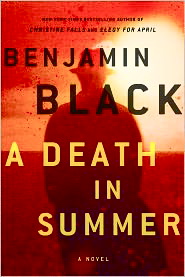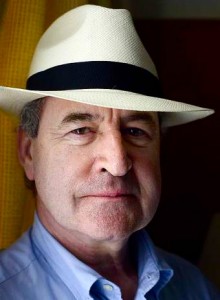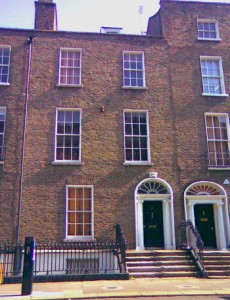Note: Benjamin Black is the pen name used by Booker Prize-winner John Banville (for The Sea, in 2005) when he writes his mystery series.
“Take the canal, there…Smooth as glass…a picture of peace and tranquility, you’d say. But think what’s going on underneath the surface, the big fish eating the little ones, and the bugs on the bottom fighting over the bits that float down, and everything covered in slime and mud.”
 In his fourth novel featuring Dr. Quirke, a Dublin pathologist at the Hospital of the Holy Family, Booker Prize-winning author John Banville, writing his mysteries as “Benjamin Black,” reveals yet another grim side of Dublin life in the early 1950s. An orphan who was sent to St. Christopher’s Orphanage when he was a child, Quirke had the good fortune to be adopted by a wealthy man who eventually put him through college and shared his life and family with him, but Quirke has never been able to enjoy family life of his own. A lost soul who has lost even more of himself in drink, Quirke is a loner, so unsure of who he really is that he is unable to trust relationships on anything more than the superficial level.
In his fourth novel featuring Dr. Quirke, a Dublin pathologist at the Hospital of the Holy Family, Booker Prize-winning author John Banville, writing his mysteries as “Benjamin Black,” reveals yet another grim side of Dublin life in the early 1950s. An orphan who was sent to St. Christopher’s Orphanage when he was a child, Quirke had the good fortune to be adopted by a wealthy man who eventually put him through college and shared his life and family with him, but Quirke has never been able to enjoy family life of his own. A lost soul who has lost even more of himself in drink, Quirke is a loner, so unsure of who he really is that he is unable to trust relationships on anything more than the superficial level.
When Dublin Detective Inspector Hackett investigates the gruesome death of “Diamond Dick” Jewell, a wealthy young entrepreneur whose head has been blown off in what is thought to be a suicide, he calls Quirke, who has unusual insights into forensics and who has helped him on several occasions in the past. Quirke quickly establishes that this death had to have been murder, and there is no dearth of suspects–“Few outside the family circle and few inside it, either, considered his demise a cause for sorrow.” The victim’s beautiful young French wife has her own life and was apparently out riding one of the horses at the Jewells’ Kildare stables where Dick Jewell died of a gunsho t wound, too far away to hear the gunshot. His sister, also in jodhpurs and riding boots, is reclining on the sofa and has apparently no curiosity at all when Quirke arrives at the house. Both have been drinking, causing Quirke to wonder, “Who were these women, really…and what was going on here.”
t wound, too far away to hear the gunshot. His sister, also in jodhpurs and riding boots, is reclining on the sofa and has apparently no curiosity at all when Quirke arrives at the house. Both have been drinking, causing Quirke to wonder, “Who were these women, really…and what was going on here.”
As Det. Insp. Hackett investigates, he finds himself relying on Dr. Quirke more and more, since Quirke has access to the elite of Dublin society, those people who know all the powerbrokers in the business community, in politics and the church, and on both sides of the law. Whom you know is more important than legal fine points in Dublin at this time, and the elite have their own helpful contacts within the police. Hackett trusts Quirke to provide him with information he might not otherwise obtain.
Banville is obviously becoming more comfortable with the mystery genre, creating a complex mystery which runs smoothly, without some of the brittle conventions of his earliest mysteries and with more natural dialogue. His descriptions are often worthy of his finest literary fiction, rich and full without being overblown, and exactly the right imagery to stick in the reader’s mind. At a scurrilous newspaper owned by the victim, for example, “The staff [upon hearing the news of his death]…felt as if they were moving underwater, or through a medium heavier and more hindering than water, and ye t at the same time everything seemed to be racing along like a river in spate and carrying all before it.”
t at the same time everything seemed to be racing along like a river in spate and carrying all before it.”
As the complicated relationships among all the main characters are revealed in the investigation of the mystery, Quirke’s own unusual history is also unwinding, and those who have read the previous mysteries will have a clear advantage in understanding who the characters are and how they relate. Quirke does have a daughter Phoebe, but he spent twenty years denying that she was his daughter (for reasons that are discussed in earlier mysteries and summarized here), and they are only now forming a relationship. He has been living with an actress with whom he has had a relatively deep relationship, but while she is working in a play, Quirke ends up on the prowl, and off the wagon, smitten by someone new.

Several subplots and an unusually large number of red herrings add complexity to the mystery. Some of the characters, including both the victim and the main suspect in the murder are Jewish, as is Quirke’s assistant at the pathology lab, and the point is made that Robert Briscoe, the new Lord Mayor of Dublin, is also Jewish. Despite the well-known horrors of World War II, and the election of Briscoe to run the city, however, Dublin is still a place in which Jews are outsiders, with considerable prejudice remaining against them. Many Jews choose to live their lives in Dublin with “non-ethnic” names, without acknowledging their family backgrounds. Some, including the victim and the main suspect in his murder, have even become members of a Catholic philanthropic organization for orphans, The Friends of St. Christopher, donating large sums to this orphanage, which once housed Quirke himself.
The relationships which the author creates between Sinclair, who is Quirke’s assistant at the pathology lab; Dannie Jewell, sister of the victim; and Phoebe, Quirke’s daughter, provide a convenient structure which allows him to explore many different sides of this murder and the characters whom it affects, while also providing a plausible con duit for information to reach Quirke which he would have no other way of learning. Quirke, in turn, can relay it to the police, who have no entrée to these social circles. Throughout, threats and unexpected violence occur regularly, and twists and turns occur, but as the reader has no idea what the motivation is behind the death of Jewell until the end of the novel, the novel seems to bog down a bit and go on too long to maintain the high level of suspense with which the novel starts. Banville is terrific in exploring character and setting, however, and his picture of Dublin in the 1950s is memorable. Ultimately, the reader will agree with one character who says, “You think you’ve seen the worst of the world, but the world and its wicked ways can always surprise you.”
duit for information to reach Quirke which he would have no other way of learning. Quirke, in turn, can relay it to the police, who have no entrée to these social circles. Throughout, threats and unexpected violence occur regularly, and twists and turns occur, but as the reader has no idea what the motivation is behind the death of Jewell until the end of the novel, the novel seems to bog down a bit and go on too long to maintain the high level of suspense with which the novel starts. Banville is terrific in exploring character and setting, however, and his picture of Dublin in the 1950s is memorable. Ultimately, the reader will agree with one character who says, “You think you’ve seen the worst of the world, but the world and its wicked ways can always surprise you.”
ALSO by Black: VENGEANCE (Quirke), THE BLACK-EYED BLONDE (Raymond Chandler), CHRISTINE FALLS (Quirke), THE SILVER SWAN (Quirke), EVEN THE DEAD (Quirke)
Photos connected to the novel: The author’s photo is from http://www.broadsheet.ie
When Teddy Sumner, son of Carlton Sumner, visits with Dannie Jewell and Phoebe Griffin, he drives a Morgan convertible, a present from his father. http://www.fsbocarsales.com
Quirke lives on Mount St., Dublin, in a house apparently like this Mount St. residence. Note the door, with its knocker, which becomes part of the story. Ironically, this photo appears on a Dublin site entitled: Quirke Estate Agents. http://www.qea.ie
Quirke and Francoise take a walk in Iveagh Gardens with her daughter Giselle near the end of the novel. This photo is by John Robertson: http://www.pbase.com
NPR has a wonderful interview with the author about this book. http://www.npr.org. Here Banville talks about his two different styles and his two different ways of writing these books. He writes the literary novels with a fountain pen and usually averages a couple of hundred words a day, he says, whereas he composes the mysteries (as B. Black) on the computer and usually averages 1500 – 2000 words a day.
